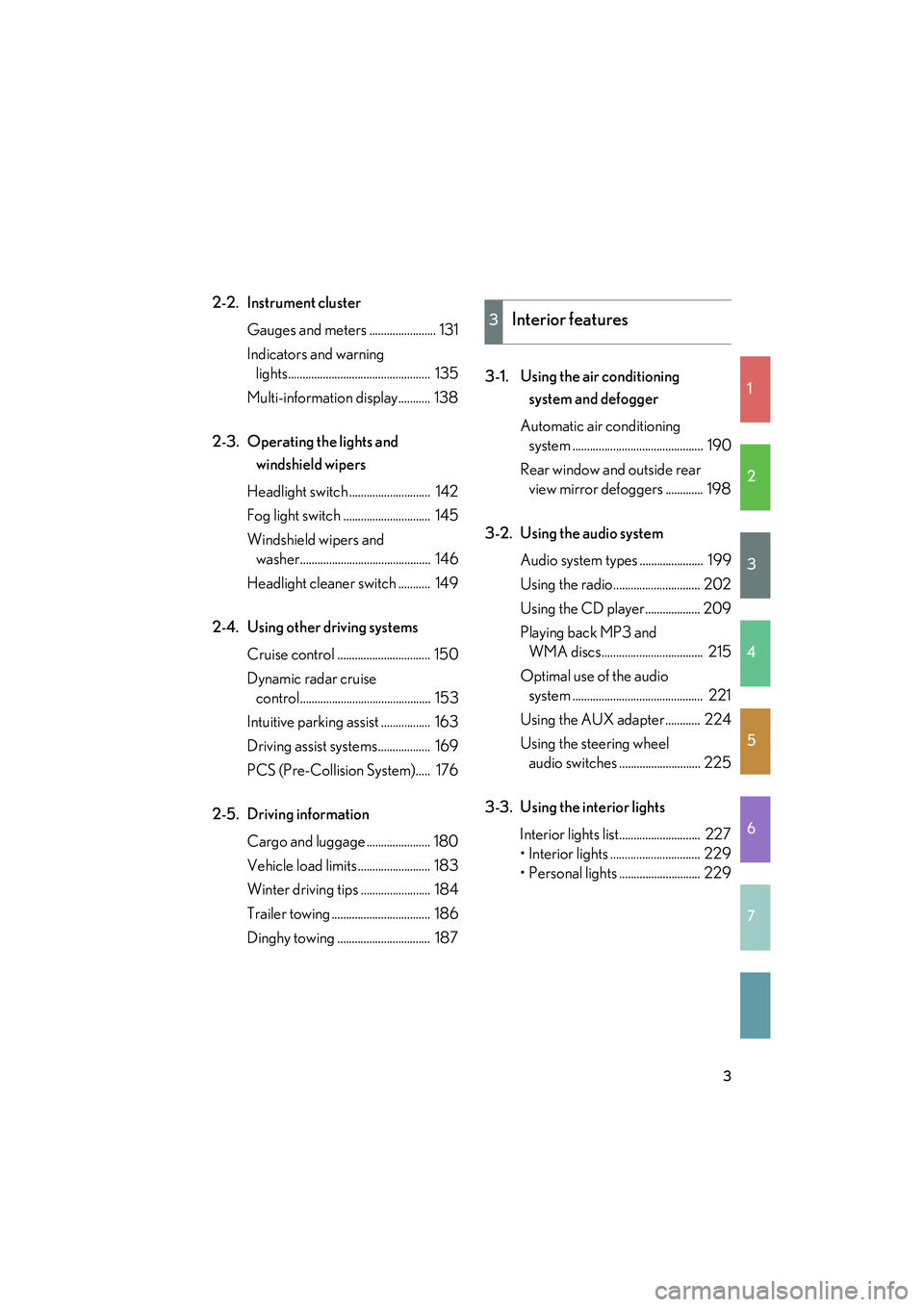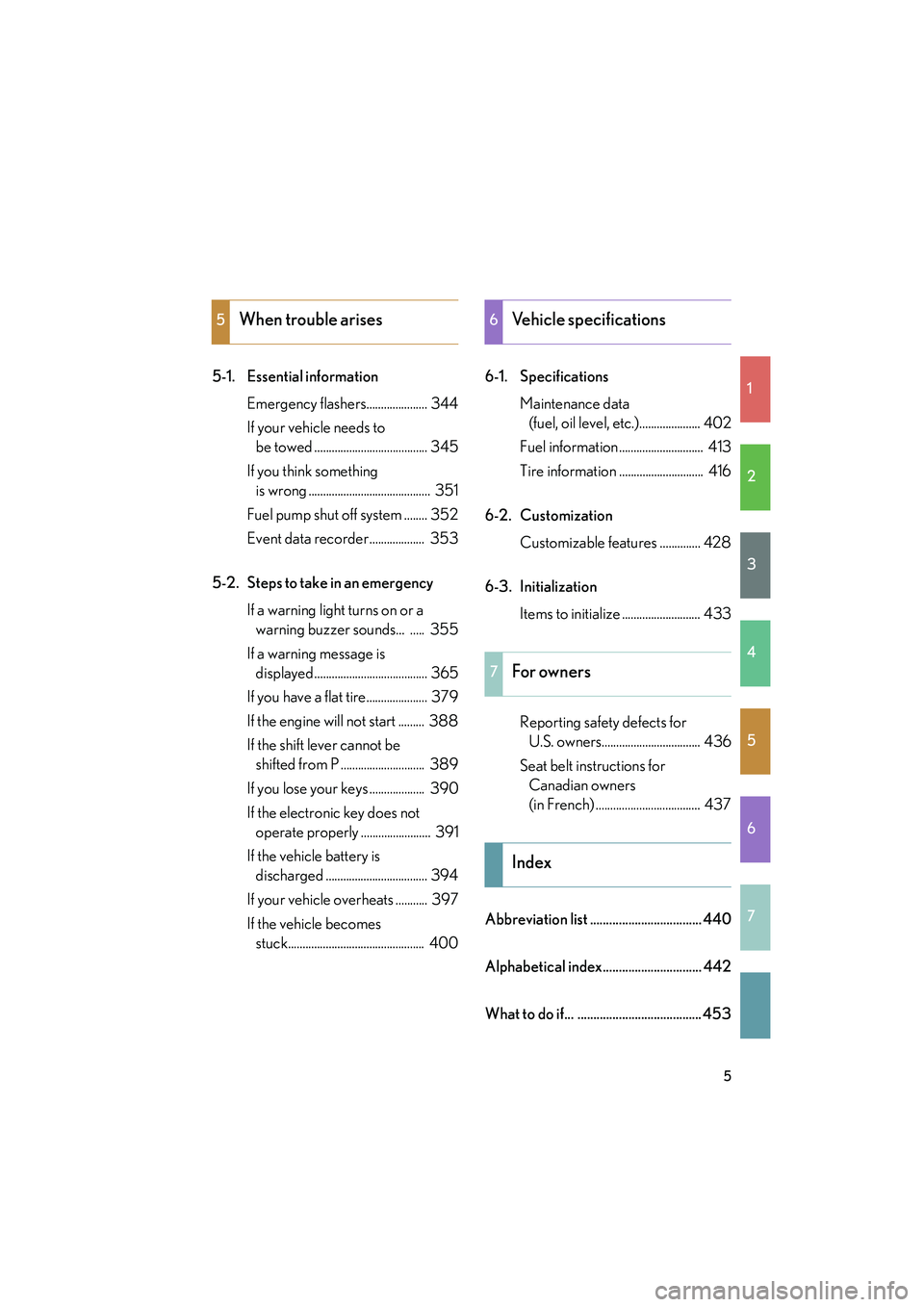Page 2 of 458
TABLE OF CONTENTS
08_IS F_U_(L/O_0808)
1
1Before drivingAdjusting and operating features such as door locks, mir-
rors, and steering column.
2When drivingDriving, stopping and safe-driving information.
3Interior featuresAir conditioning and audio systems, as well as other interior
features for a comfortable driving experience.
4Maintenance
and careCleaning and protecting your vehicle, performing do-it-your-
self maintenance, and maintenance information.
5When trouble
arisesWhat to do if the vehicle needs to be towed, gets a flat tire,
or is involved in an accident.
6Ve h i c l e
specificationsDetailed vehicle information.
7For ownersReporting safety defects for US owners and seat belt in-
structions for Canadian owners
IndexAlphabetical listing of information contained in this manual.
Page 4 of 458

1
2
3
4
5
6
7
08_IS F_U_(L/O_0808)
3
2-2. Instrument clusterGauges and meters ....................... 131
Indicators and warning lights................................................. 135
Multi-information display........... 138
2-3. Operating the lights and windshield wipers
Headlight switch ............................ 142
Fog light switch .............................. 145
Windshield wipers and washer............................................. 146
Headlight cleaner switch ........... 149
2-4. Using other driving systems Cruise control ................................ 150
Dynamic radar cruise control............................................. 153
Intuitive parking assist ................. 163
Driving assist systems.................. 169
PCS (Pre-Collision System)..... 176
2-5. Driving information Cargo and luggage ...................... 180
Vehicle load limits ......................... 183
Winter driving tips ........................ 184
Trailer towing .................................. 186
Dinghy towing ................................ 187 3-1. Using the air conditioning
system and defogger
Automatic air conditioning system ............................................. 190
Rear window and outside rear view mirror defoggers ............. 198
3-2. Using the audio system Audio system types ...................... 199
Using the radio.............................. 202
Using the CD player................... 209
Playing back MP3 and WMA discs................................... 215
Optimal use of the audio system ............................................. 221
Using the AUX adapter............ 224
Using the steering wheel audio switches ............................ 225
3-3. Using the interior lights Interior lights list............................ 227
• Interior lights ............................... 229
• Personal lights ............................ 229
3Interior features
Page 6 of 458

1
2
3
4
5
6
7
08_IS F_U_(L/O_0808)
5
5-1. Essential informationEmergency flashers..................... 344
If your vehicle needs to be towed ....................................... 345
If you think something is wrong .......................................... 351
Fuel pump shut off system ........ 352
Event data recorder................... 353
5-2. Steps to take in an emergency If a warning light turns on or a warning buzzer sounds... ..... 355
If a warning message is displayed....................................... 365
If you have a flat tire..................... 379
If the engine will not start ......... 388
If the shift lever cannot be shifted from P ............................. 389
If you lose your keys ................... 390
If the electronic key does not operate properly ........................ 391
If the vehicle battery is discharged ................................... 394
If your vehicle overheats ........... 397
If the vehicle becomes stuck............................................... 400 6-1. Specifications
Maintenance data (fuel, oil level, etc.)..................... 402
Fuel information............................. 413
Tire information ............................. 416
6-2. Customization Customizable features .............. 428
6-3. Initialization Items to initialize ........................... 433
Reporting safety defects for U.S. owners.................................. 436
Seat belt instructions for Canadian owners
(in French) .................................... 437
Abbreviation list ................................... 440
Alphabetical index............................... 442
What to do if... ....................................... 453
5When trouble arises6Vehicle specifications
7For owners
Index
Page 29 of 458

28
1-2. Opening, closing and locking the doors and trunk
08_IS F_U_(L/O_0808)
■Operation signals
A buzzer sounds and the emergency flashers flash to indicate that the doors have
been locked/unlocked. (Locked: Once; Unlocked: Twice)
■Conditions affecting operation
The smart access system with push-button start uses weak radio waves. In the fol-
lowing situations, the communication between the electronic key and the vehicle
may be affected, preventing the smart access system with push-button start from
operating properly:
(Ways of coping: →P. 3 9 1 )
●When the electronic key battery is depleted
●Near a TV tower, electric power plant, gas station, radio station, large display,
airport or other facility that generates strong radio waves or electrical noise
●When carrying a portable radio, cellular phone, cordless phone or other wire-
less communication devices
●When the electronic key is in contact with, or is covered by the following metal-
lic objects
• Cards to which aluminum foil is attached
• Cigarette boxes that have aluminum foil inside
• Metallic wallets or bags
•Coins
• Hand warmers made of metal
• Media such as CDs and DVDs
●When multiple electronic keys are in the vicinity
●When another wireless key (that emits radio waves) is being used nearby
●When carrying or using the electronic key together with the following devices
that emit radio waves
• Another vehicle's electronic key or a wireless key that emits radio waves
• Personal computer or personal digital assistant (PDA)
• Digital audio player
• Portable game system
●If window tint with a metallic content or metallic objects are attached to the rear
window
Page 52 of 458
51
1
1-3. Adjustable components (seats, mirrors, steering wheel)
Before driving
08_IS F_U_(L/O_0808)
Head restraints
■Adjusting the height of the head restraints
■Adjusting the rear seat head restraints
Always raise the head restraint one level from the stowed position when using.
CAUTION
■Head restraint precautions
Observe the following precautions regarding the head restraints. Failure to do so
may result in death or serious injury.
●Use the head restraints designed for each respective seat.
●Adjust the head restraints to the correct position at all times.
●Do not drive with the head restraints removed.
Vertical adjustment
Push and hold the lock release
button when lowering the head
restraint.
Removal
Pull the head restraint up while
pushing the lock release button.
Lock
release
button
Make sure that the head restraints are
adjusted so that the center of the head
restraint is closest to the top of your ears.
Page 59 of 458
58
1-3. Adjustable components (seats, mirrors, steering wheel)
08_IS F_U_(L/O_0808)
Steering wheel
Auto tilt awayWhen the “ENGINE START
STOP” switch is turned OFF, the
steering wheel returns to its
stowed position by moving up and
away to enable easier driver entry
and exit.
Switching to ACCESSORY or
IGNITION ON mode will return
the steering wheel to the original
position.
The steering wheel can be adjusted to a comfortable position.
Up
Down
Away from the driver
Toward the driver
Page 85 of 458

84
1-7. Safety information
08_IS F_U_(L/O_0808)
CAUTION
■SRS airbag precautions
Observe the following precautions regarding the airbags.
Failure to do so may cause death or serious injury.
●The driver and all passengers in the vehicle must wear their seat belts properly.
The SRS airbags are supplemental devices to be used with the seat belts.
●The SRS driver airbag deploys with considerable force, and can cause death or
serious injury especially if the driver is very close to the airbag. The National
Highway Traffic Safety Administration (“NHTSA”) advises:
Since the risk zone for driver airbag is the first 2 - 3 in. (50 - 75 mm) of inflation,
placing yourself 10 in. (250 mm) from your driver airbag provides you with a
clear margin of safety. This distance is measured from the center of the steering
wheel to your breastbone. If you sit less than 10 in. (250 mm) away now, you can
change your driving position in several ways:
• Move your seat to the rear as far as you can while still reaching the pedalscomfortably.
• Slightly recline the back of the seat. Although vehicle designs vary, many drivers can achieve the 10 in. (250 mm)
distance, even with the driver seat all the way forward, simply by reclining the
back of the seat somewhat. If reclining the back of your seat makes it hard to
see the road, raise yourself by using a firm, non-slippery cushion, or raise the
seat if your vehicle has that feature.
• If your steering wheel is adjustable, tilt it downward. This points the airbag toward your chest instead of your head and neck.
The seat should be adjusted as recommended by NHTSA above, while still main-
taining control of the foot pedals, steering wheel, and your view of the instrument
panel controls.
Page 87 of 458
86
1-7. Safety information
08_IS F_U_(L/O_0808)
CAUTION
■SRS airbag precautions
●Do not sit on the edge of the seat or lean
against the dashboard.
●Do not allow a child to stand in front of the
SRS front passenger airbag unit or sit on
the knees of a front passenger.
●Do not drive the vehicle while the driver or
passenger have items resting on their
knees.
●Do not lean against the door, the roof side
rail or the front, side and rear pillars.
●Do not allow anyone to kneel on the pas-
senger seat toward the door or put their
head or hands outside the vehicle.